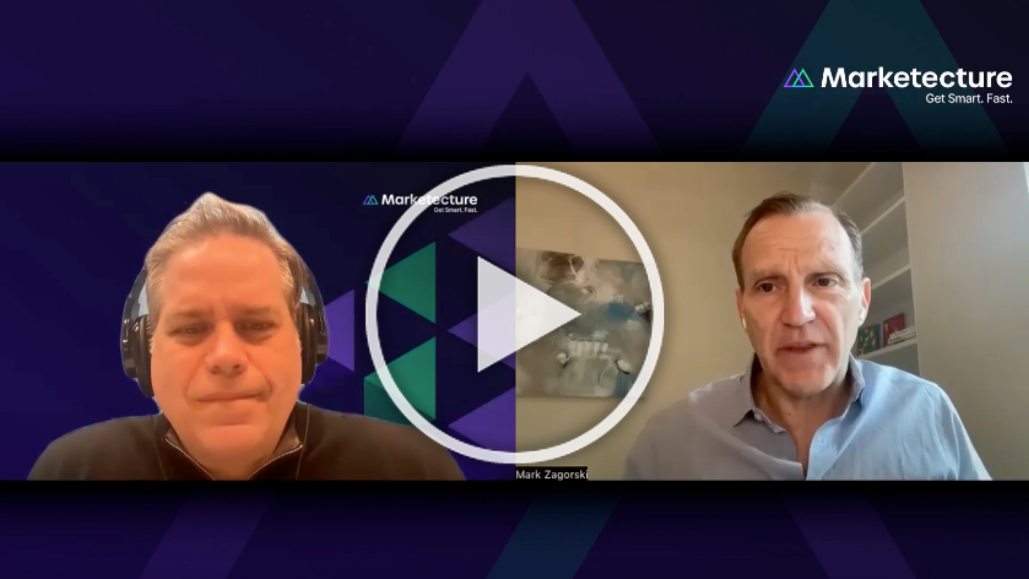Save 50% on a 3-month Digiday+ membership. Ends Dec 5.
From CTV to walled gardens, new measurement challenges emerge for advertisers

Produced in partnership with Marketecture
The following article highlights an interview between Mark Zagorski, CEO of DoubleVerify, and Ari Paparo, founder and CEO of Marketecture. Register for free to watch more of the discussion and learn how DoubleVerify is tackling new measurement challenges in viewability, fraud and brand safety.
As digital ad environments and measurement solutions evolve, advertisers are increasingly valuing safe, secure and efficient ad spend.
Measurement companies like DoubleVerify work with advertisers to ensure brand suitability and avoid fraud across the digital ecosystem. Mark Zagorski, CEO of DoubleVerify, recently spoke with Ari Paparo, founder and CEO of Marketecture, to discuss how DoubleVerify is helping clients measure and filter authentic ads.
“The business has evolved to where we are today, where we still have the same thesis of driving a stronger, safer, more secure digital ad ecosystem,” Zagorski said. “Viewability, fraud, brand safety and suitability and geographic alignment form the core of what we call the authentic ad.”
Ad position: web_incontent_pos1
How walled gardens pose a challenge for ad verification
For advertisers to accurately gauge their return on ad spend, they must have a standard across the channels and platforms where they spend. Having set standards for ad verification ensures that ads are measured and evaluated uniformly — limiting discrepancies in measurement and making it easier for advertisers to compare ad performance across different platforms, channels or campaigns.
While consistency is critical, Zagorski said DoubleVerify faces two significant verification challenges. The first is measuring different content or media types, such as video, display or CTV. The second, less technical challenge involves gaining access to data from Facebook, YouTube, TikTok, Netflix and other walled gardens.
“Part of the relationship with these platforms is they provide us the data, and now we have to vet that data and make sure it meets our minimum bar,” Zagorski said. “There’s definitely a bit of push and pull when it comes to the walled gardens as to what we can use and what they’ll provide us.”
In some instances, walled gardens also make it more challenging for advertisers to block placements that don’t meet targeting or other requirements. Zagorski explained that this contributed to advertisers’ boycott of Facebook in 2020 since many were unsatisfied with the platform’s ability to control content.
Ad position: web_incontent_pos2
With this in mind, DoubleVerify has evolved from a brand safety approach to brand suitability — helping advertisers avoid dark spaces on the web and places that aren’t aligned with their brand.
“Advertisers have hundreds of categories with multiple levels of sensitivity to turn their dial against,” Zagorski said. “They know how we analyze content, and they decide what they want to do.”
Emerging channels come with their own risks for ad fraud
To navigate the increasingly complex digital advertising ecosystem, DoubleVerify is leaning more on automation to help clients manage their campaigns.
New offerings include campaign automation, which makes adding a DoubleVerify tag on Google Campaign Manager seamless, and Authentic Direct, which applies a filtering approach offered for programmatic ads to direct buys. This allows publishers to access a dynamic and centralized set of brand safety and suitability requirements for clients and deploy these across their campaigns.
DoubleVerify is also investing in CTV verification solutions, aiming to meet increased advertiser demand for media quality on this growing channel.
With advertisers ramping up their investments in CTV, avoiding fraudulent impressions is critical amid viewability challenges. As Zagorski explained, the IAB viewability standard — a measure of whether or not an ad had a chance to be seen by a user — for CTV ads is only two seconds, while 25% of CTV apps continue to serve ads even after they are turned off.
However, Zagorski expects that attention will soon surpass the importance of viewability.
“There are a lot of proxies for performance, like reach and frequency, but we believe that attention is one that actually should be part of the dialogue,” Zagorski said. “We look at attention as being the cross-section of exposure and engagement.”
DoubleVerify’s attention measurement offering enables advertisers to see the attention level for individual impressions compared to their standard attention level and those of others in their sector. Ads that command greater attention perform better against multiple KPIs.
No matter the channel, refining targeting and content filtering is a vital step for advertisers to limit fraud and ad waste for more efficient spend.
“When it comes to viewability, the advertisers are putting in their own criteria in many cases that are even beyond the IAB viewability levels, and that’s what we filter against,” Zagorski said. “Now, if they want to use somebody else to check our work, they could always do that, but we don’t give guarantees. We just deliver results.”
Register for free to watch more of the discussion between Ari Paparo and Mark Zagorski and learn how the ad verification space continues to evolve.
Produced in partnership with Marketecture
More from Digiday

Ulta, Best Buy and Adidas dominate AI holiday shopping mentions
The brands that are seeing the biggest boost from this shift in consumer behavior are some of the biggest retailers.

Digiday+ Research Subscription Index 2025: Subscription strategies from Bloomberg, The New York Times, Vox and others
Digiday’s third annual Subscription Index examines and measures publishers’ subscription strategies to identify common approaches and key tactics among Bloomberg, The New York Times, Vox and others.

U.K. retailer Boots leads brand efforts to invest in ad creative’s data layer
For media dollars to make an impact, brands need ad creative that actually hits. More CMOs are investing in pre- and post-flight measurement.
Ad position: web_bfu





